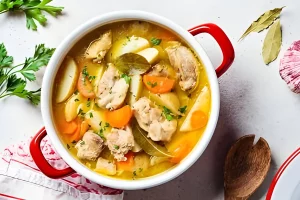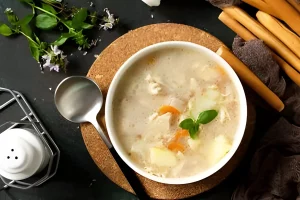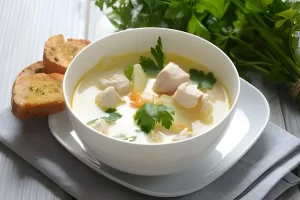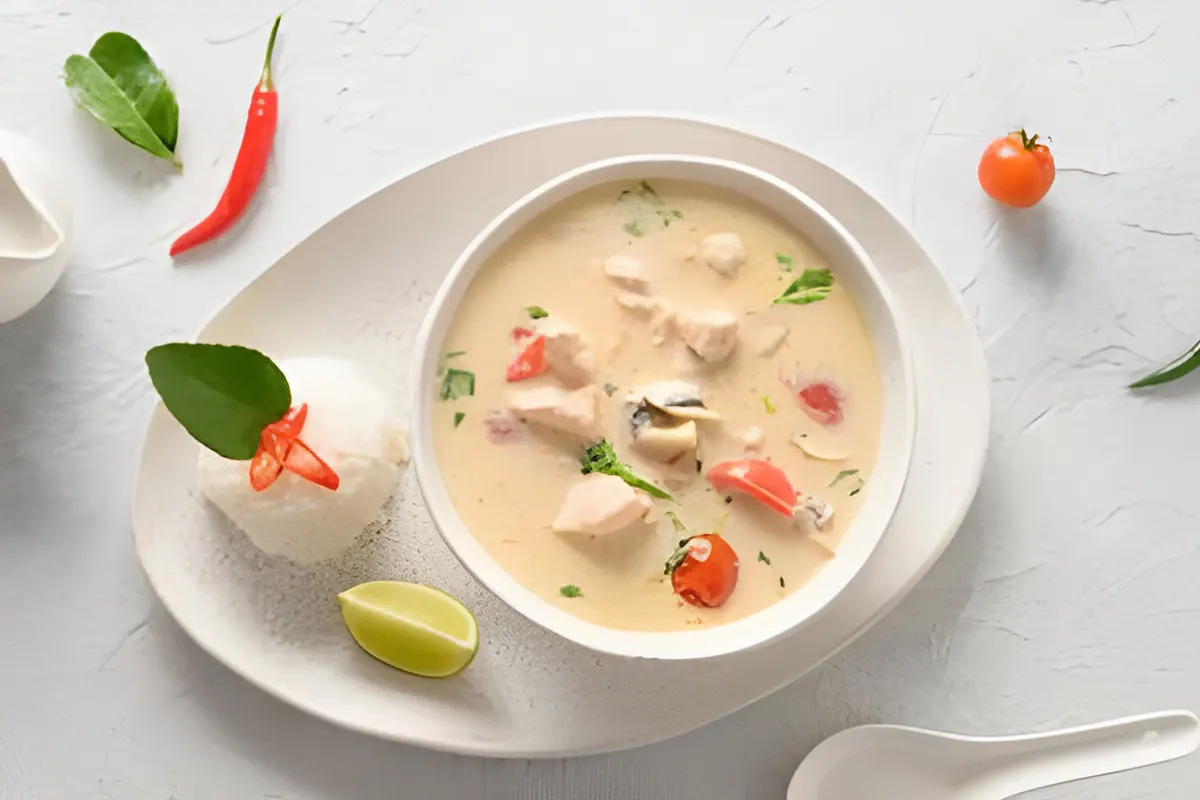In every culture, chicken soup is a staple, passed down through generations. It’s more than food; it’s comfort and home. This article explores its benefits, variations, and the warmth it brings.
Introduction to Chicken Soup
Ah, chicken soup – isn’t it just the epitome of comfort in a bowl? Whether you’re under the weather or just in need of a warm hug from the inside, chicken soup seems to be everyone’s go-to remedy. But have you ever paused to ponder why this simple concoction of chicken, broth, and vegetables holds such a special place in our hearts and hearths?
The universal appeal of chicken soup stretches far beyond its soothing warmth. It’s a dish steeped in history, with each spoonful carrying the whispers of generations past. From the Jewish Matzo Ball Soup to the Mexican Caldo de Pollo, every culture has its own cherished version, making chicken soup a culinary mosaic of global traditions.
But what really makes chicken soup a staple in kitchens around the world? Well, for starters, it’s the art of simplicity. With just a few ingredients, one can conjure up a meal that nourishes the body and soul. Plus, it’s incredibly versatile – throw in whatever veggies you have lying around, and voilà, you’ve got yourself a pot of golden goodness.
And let’s not forget the tales of its medicinal prowess. From grandmas’ claims of its cold-busting abilities to scientific nods towards its immune-boosting properties, chicken soup seems to be the delicious panacea we all need once in a while.
So, as we embark on this savory journey through the world of chicken soup, let’s ready our spoons and open our hearts to the stories and flavors simmering in every pot. After all, in the world of comfort foods, chicken soup is undoubtedly the reigning monarch, offering a warm embrace with every bite.

Nutritional and Health Benefits
Diving into a bowl of chicken soup isn’t just a feast for the senses; it’s a veritable treasure trove of nutrients that can bolster your health in more ways than one. Ever wonder why a steaming bowl of this comfort food feels like a warm hug to your insides? Well, the secret lies in its ingredients, each bringing a host of benefits to the table.
The Protein Punch: Chicken
First off, the star of the show, chicken, is a fantastic source of lean protein, essential for muscle repair and growth. But the magic doesn’t stop there. The broth, oh that golden elixir, is rich in minerals like calcium, magnesium, and phosphorus, which are crucial for bone health. And when you throw in a variety of veggies, you’re not just adding color and flavor; you’re infusing the soup with vitamins and antioxidants that boost your immune system and fight inflammation.
A Balm for the Soul: Psychological Effects
But here’s the kicker – chicken soup isn’t just good for the body; it’s a balm for the soul too. Ever noticed how a bowl of this soup can lift your spirits on a dreary day? That’s because comfort foods like chicken soup have a psychological effect, reducing stress and evoking a sense of well-being and nostalgia.
And for those sniffly, sneezy days when you’re battling a cold, chicken soup might just be your best ally. It’s not just an old wives’ tale; studies suggest that chicken soup can help alleviate cold symptoms, thanks to its ability to clear nasal congestion and potentially anti-inflammatory effects. So, next time you’re feeling under the weather, you know what to whip up!
A Culinary Superhero: Chicken Soup’s Enduring Legacy
In a world brimming with dietary choices, chicken soup stands out as a beacon of nourishment and comfort. It’s a testament to the power of simple, wholesome ingredients coming together to create something that not only feeds the body but also heals the soul. So, let’s raise our spoons to this humble yet mighty dish, a true superhero in the culinary world.
Classic and Global Variations
Chicken soup may have its roots in simplicity, but the global tapestry of recipes tells a story of incredible diversity and creativity. From the comforting classic chicken noodle soup in the heart of America to the aromatic Pho of Vietnam, each variation of chicken soup carries the essence of its cultural heritage, reflecting the FAO’s emphasis on the importance of traditional foods in cultural identity, making every spoonful a journey around the world.
Classic Chicken Noodle Soup
Let’s start with the quintessential chicken noodle soup – a dish that many of us turn to for comfort and warmth. This classic concoction combines tender pieces of chicken, hearty noodles, and a medley of vegetables like carrots, celery, and onions, all swimming in a savory broth. It’s the kind of soup that reminds you of home, no matter where you are in the world.
Global Variations of Chicken Soup
But the adventure doesn’t stop there. Venture a little further, and you’ll find yourself savoring the vibrant flavors of Pho in Vietnam, a noodle soup known for its rich, spiced broth and fresh herbs. Or perhaps you’ll find comfort in a bowl of Matzo Ball Soup, a staple in Jewish cuisine, with its fluffy dumplings and clear chicken broth.
And let’s not forget the zesty Pozole Verde from Mexico, a hominy-based stew that gets its tangy kick from tomatillos and green chiles. Each of these soups, with their unique ingredients and preparation methods, showcases the versatility and global appeal of chicken soup.
But what truly makes these variations special is not just the ingredients or the cooking techniques; it’s the stories and traditions behind each bowl. Whether it’s a family recipe passed down through generations or a dish that marks a special occasion, chicken soup is more than just food; it’s a celebration of culture and community.
So, as we explore the myriad ways to prepare chicken soup, let’s embrace the diversity and richness that each culture brings to the table. In the world of chicken soup, there’s always something new to discover, a new flavor to savor, and a new story to tell. And isn’t that just the most beautiful thing about food?

Special Dietary Considerations
Chicken soup adapts to many diets, but “Does chicken soup have gluten?” is common. Traditional versions might, but gluten-free options abound. Use rice or veggie noodles and gluten-free thickeners. For vegetarians and vegans, plant-based broths and hearty veggies work well. Chicken soup can fit any diet, offering comfort to all.
Gluten-Free Chicken Soup Options
Traditionally, chicken soup, especially the classic chicken noodle variety, contains gluten due to the presence of wheat-based noodles and, occasionally, thickeners in the broth. However, fear not, as the world of chicken soup is as adaptable as it is vast. For a gluten-free version, one can easily substitute regular noodles with those made from rice, quinoa, or even vegetables like zucchini spirals. Moreover, ensuring the broth is thickened with gluten-free alternatives, such as cornstarch or arrowroot powder, can make your chicken soup safe for those avoiding gluten.
Does Chicken Soup Have Gluten?
To directly address the question, the presence of gluten in chicken soup largely depends on the ingredients used. While homemade chicken soup can be easily adapted to be gluten-free, caution should be exercised with store-bought varieties or restaurant servings, as these may contain gluten-containing ingredients. Always check labels or inquire about the ingredients to ensure the soup meets your dietary needs.
Vegetarian and Vegan Alternatives
But what about those who don’t include chicken or any animal products in their diet? The essence of chicken soup – its warmth, comfort, and nourishment – can still be captured in vegetarian and vegan versions. Using a rich vegetable broth as the base and incorporating hearty ingredients like beans, lentils, and a plethora of vegetables can create a soup that’s both satisfying and inclusive. Nutritional yeast or umami-rich mushrooms can add depth to the broth, mimicking the savory quality of chicken.
In the realm of chicken soup, there’s a bowl for everyone. Whether you’re gluten-free, vegetarian, or vegan, the spirit of this comforting classic can be preserved and adapted to suit your dietary needs. So, gather your ingredients, and let’s keep the tradition of chicken soup alive, in all its diverse and inclusive glory.
Cooking Tips and Tricks
Mastering the art of chicken soup is akin to holding a culinary symphony in your hands. Each ingredient plays a crucial role, and when harmonized perfectly, the result is a soul-soothing melody of flavors. Whether you’re a seasoned chef or a kitchen novice, these tips and tricks will elevate your chicken soup from good to unforgettable.
Preparing the Perfect Chicken Soup
The foundation of a great chicken soup lies in its broth. Starting with a base of cold water and slowly bringing it to a simmer with your chicken allows for a clearer broth and more tender meat. Consider using a whole chicken or chicken parts with bones, as the bones enrich the broth with depth, flavor, and nutrients.
Vegetables are the next key players. Onions, carrots, and celery, often referred to as the “holy trinity” in cooking, provide a classic flavor base. But don’t be afraid to get creative and add other veggies like leeks, parsnips, or turnips for an extra layer of taste.
Herbs and spices are the magic touch that can transform your soup. Bay leaves, thyme, parsley, and dill are traditional choices that never disappoint. However, exploring with ginger, turmeric, or even a dash of paprika can introduce an exciting twist to your recipe.
And what about the noodles? If you’re adding them, consider cooking them separately and adding them to individual servings. This way, they remain al dente and don’t absorb too much broth, ensuring your soup is perfect from the first bowl to the last.
Storing and Reheating Chicken Soup
Leftover chicken soup is a gift that keeps on giving, provided it’s stored correctly. Cool your soup quickly and refrigerate it within two hours of cooking to maintain its freshness and safety. Stored in airtight containers, your soup can be a quick, comforting meal for up to four days in the fridge or up to six months in the freezer.
When it comes to reheating, patience is key. Gently warm the soup on the stove over low heat to preserve the flavors and textures. If you’ve frozen your soup, thawing it in the fridge before reheating is the best approach to ensure even warming.
In the world of chicken soup, the devil truly is in the details. With these tips and tricks up your sleeve, you’re well on your way to crafting a pot of chicken soup that’s not just a meal, but a warm embrace in a bowl. So, tie on your apron, and let the magic begin!

FAQs
In the realm of chicken soup, curiosity bubbles up just as surely as the broth simmers. From its storied history to the secrets behind its comforting power, questions abound. Let’s ladle through some of the most common inquiries, adding a sprinkle of clarity to our soup pot of knowledge.
Can chicken soup truly help when you’re sick?
Ah, the age-old question that echoes from kitchens and sickbeds alike. While chicken soup isn’t a cure-all, it’s more than just an old wives’ tale. The steam can help clear nasal congestion, and the warm broth soothes sore throats. Plus, it’s hydrating and easy to digest, making it a go-to for gentle nourishment when your body is under the weather.
How can I make my chicken soup more flavorful?
If your chicken soup tastes more like a timid broth than a flavorful feast, consider a few tweaks. First, don’t skimp on the seasoning – salt, pepper, and herbs can dramatically elevate the taste. Roasting the chicken and vegetables before adding them to the pot can also add depth. Lastly, a splash of acidity, like lemon juice, can brighten the flavors.
Is chicken soup good for weight loss?
Chicken soup can be a fantastic addition to a weight-loss diet, thanks to its high protein content and low calorie count. Opting for a broth-based soup loaded with vegetables can keep you full and satisfied without the extra calories. Just be mindful of the sodium content, especially in store-bought versions.
How long does chicken soup last in the fridge?
Properly stored in an airtight container, homemade chicken soup can last 3-4 days in the fridge. If you’ve made a large batch, consider freezing portions for later use. Just remember, when it comes to leftovers, when in doubt, throw it out.
Can I freeze chicken soup?
Absolutely! Chicken soup freezes beautifully, making it a fantastic make-ahead meal. Just leave out the noodles or rice if you plan to freeze it, as they can become mushy when reheated. Freeze in portion-sized containers for up to 6 months for best quality.
In the cozy kitchen of chicken soup lore, every question leads us closer to perfecting our pot. So, keep the queries coming, and let’s continue to stir up not just soup, but stories, comfort, and care with every batch we brew.
Conclusion
As we reach the end of our chicken soup journey, it’s clear this dish is more than a meal, echoing the FAO’s perspective on the value of traditional foods in bringing comfort and connection. It’s a mix of tradition, comfort, and health in every spoonful. From the go-to chicken noodle for cold days to the rich global variations, chicken soup speaks a universal language of care.
We’ve dived into its nutritional benefits and how it meets various dietary needs. We’ve shared tips to boost flavors and make each pot unique. The FAQs answered common questions, showing that behind every query is a shared moment or a new discovery.
In sum, chicken soup is more than its ingredients. It’s a gesture of love, a generational remedy, and a nod to life’s simple joys. So, here’s to chicken soup, a simple dish with deep meaning, reminding us of the comfort and connection found in every bowl.

